Mayr E.W., Pr?mel H.J., Steger A. (eds.) Lectures on Proof Verification and Approximation Algorithms
Подождите немного. Документ загружается.

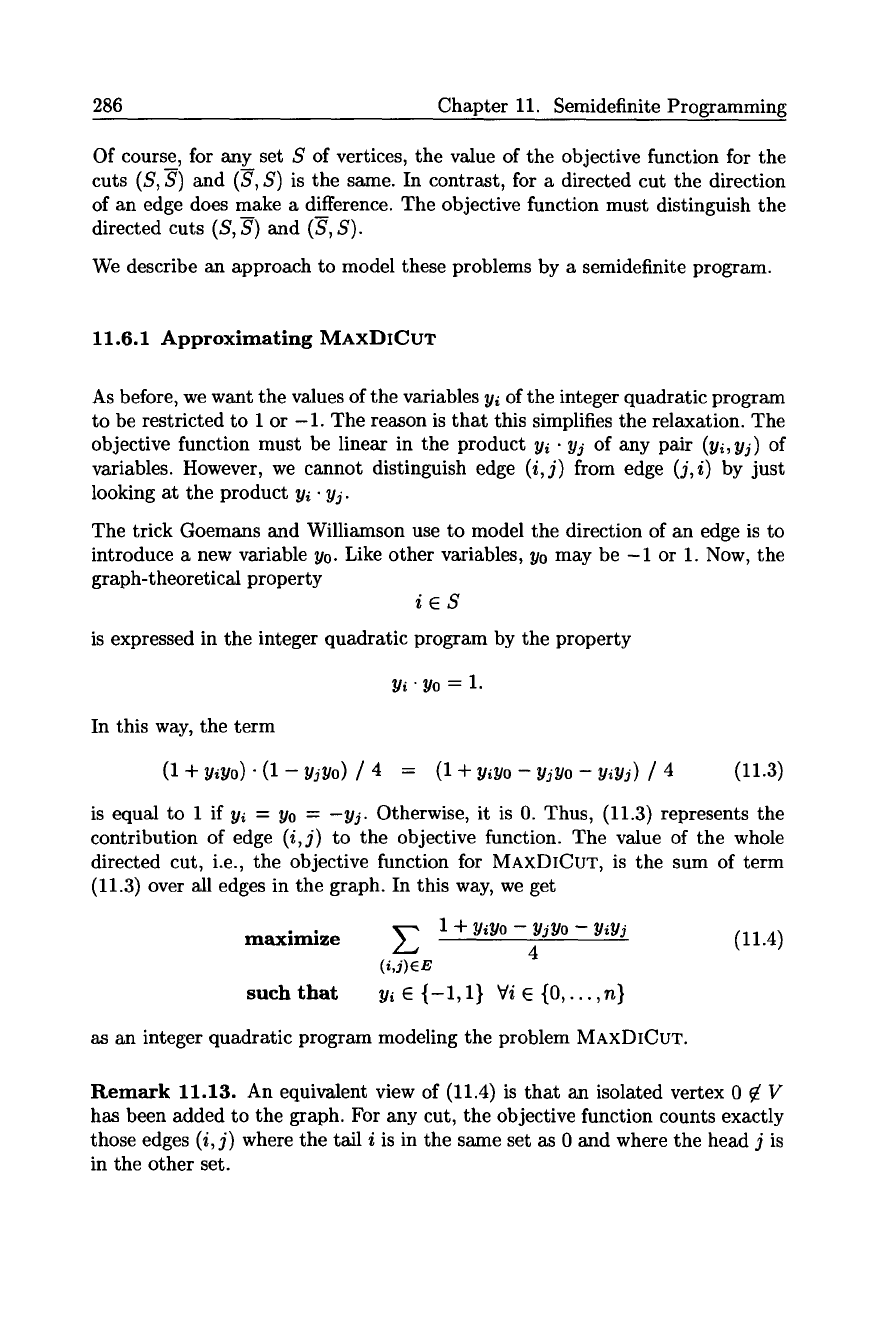
286 Chapter 11. Semidefinite Programming
Of course, for any set S of vertices, the value of the objective function for the
cuts (S, S) and (S, S) is the same. In contrast, for a directed cut the direction
of an edge does make a difference. The objective function must distinguish the
directed cuts (S, S) and (3, S).
We describe an approach to model these problems by a semidefinite program.
11.6.1 Approximating MAxDICuT
As before, we want the values of the variables
yi
of the integer quadratic program
to be restricted to 1 or -1. The reason is that this simplifies the relaxation. The
objective function must be linear in the product
Yi 9 Yj
of any pair
(Yi, yj)
of
variables. However, we cannot distinguish edge (i,j) from edge
(j,i)
by just
looking at the product
Yi 9 Yj.
The trick Goemans and Williamson use to model the direction of an edge is to
introduce a new variable Y0. Like other variables, Y0 may be -1 or 1. Now, the
graph-theoretical property
iES
is expressed in the integer quadratic program by the property
Yi'Yo = 1.
In this way, the term
(l+yiyo)-(1-yjyo) /4 = (l+yiYo-yjyo-yiyj) /4 (11.3)
is equal to 1 if
yi = Yo = -Yj.
Otherwise, it is 0. Thus, (11.3) represents the
contribution of edge
(i,j)
to the objective function. The value of the whole
directed cut, i.e., the objective function for MAXDICUT, is the sum of term
(11.3) over all edges in the graph. In this way, we get
1 + YiYo - YjYo - YiYj
maximize
(11.4)
4
such that
Yi E
{-1, 1} Vi e {0,..., n}
as an integer quadratic program modeling the problem MAxDICuT.
Remark 11.13. An equivalent view of (11.4) is that an isolated vertex 0 r V
has been added to the graph. For any cut, the objective function counts exactly
those edges (i,j) where the tail i is in the same set as 0 and where the head j is
in the other set.
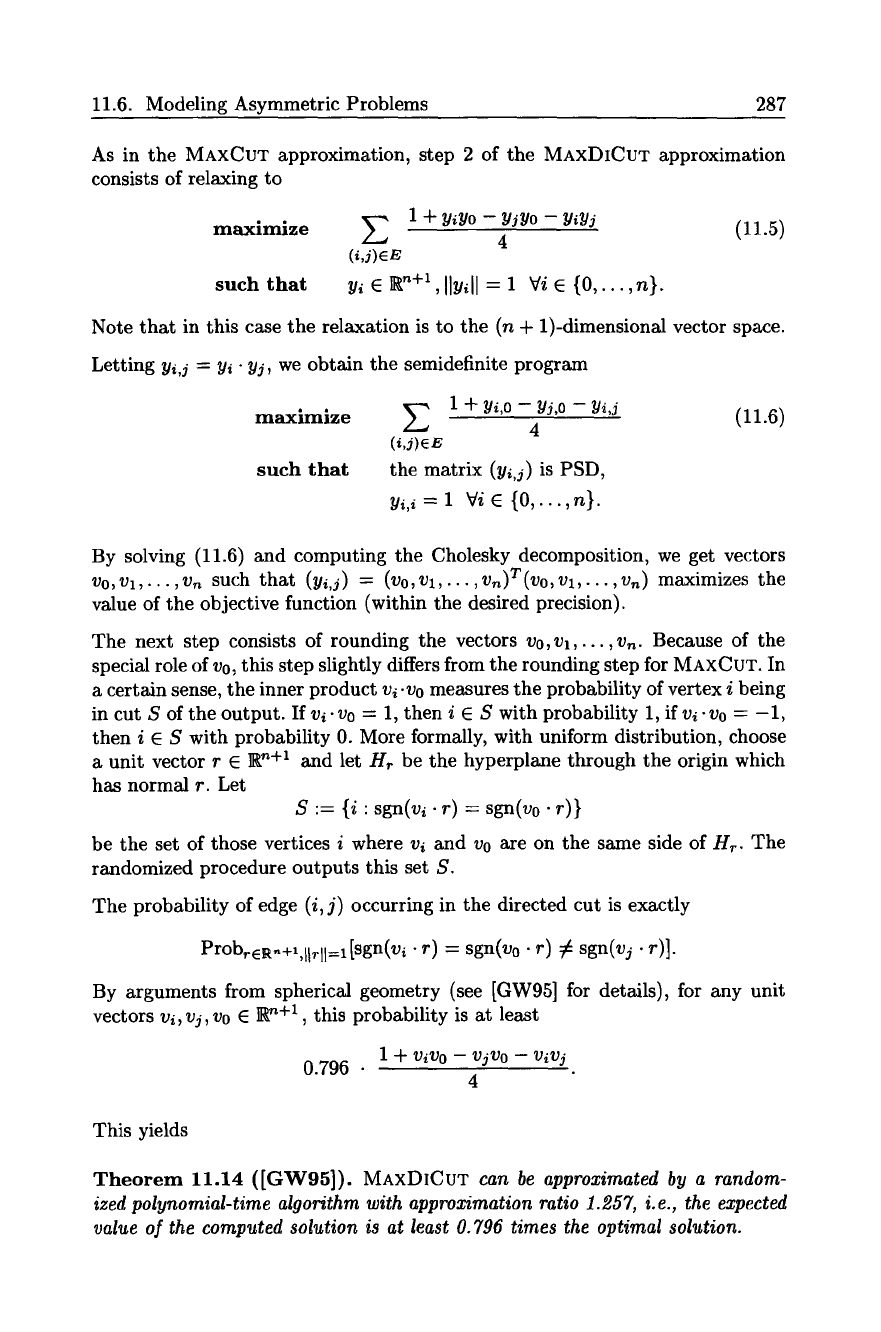
11.6. Modeling Asymmetric Problems 287
As in the MAXCUT approximation, step 2 of the MAXDICUT approximation
consists of relaxing to
K-~ 1 + YiYo -- YjYo -- YiYj
maximize (11.5)
A.,
4
(ij)eE
such that
Yi ~ ~,+1,
IlY~II ---- 1 Vie {0,..., n}.
Note that in this case the relaxation is to the (n + 1)-dimensional vector space.
Letting yi,j = Yi 9 Yj, we obtain the semidefinite program
X-" 1 + y~,o - Yzo - yi,j
maximize
(11.6)
A..,
4
(i,j)eE
such that the matrix (yi,j) is PSD,
Yi,i=l
Vie {0,...,n}.
By solving (11.6) and computing the Cholesky decomposition, we get vectors
Vo,Vl,...,vn
such that
(yi,j) = (Vo,Vl,...,vn)T(vo,vl,...,vn)
maximizes the
value of the objective function (within the desired precision).
The next step consists of rounding the vectors
vo,vl,...,vn.
Because of the
special role of vo, this step slightly differs from the rounding step for MAXCUT. In
a certain sense, the inner product
vi'vo
measures the probability of vertex i being
in cut S of the output.
Ifvi-v0
= 1, then i E S with probability 1,
ifvi "Vo = -1,
then i E S with probability 0. More formally, with uniform distribution, choose
a unit vector r E R n+l and let Hr be the hyperplane through the origin which
has normal r. Let
S := {i : sgn(vi 9 r) = sgn(v0, r)}
be the set of those vertices i where
vi and vo axe
on the same side of Hr. The
randomized procedure outputs this set S.
The probability of edge (i, j) occurring in the directed cut is exactly
Prob~eR~+,,lirll=l[sgn(vi.
r) = sgn(vo- r) ~ sgn(vj, r)].
By arguments from spherical geometry (see [GW95] for details), for any unit
vectors
vi, vj, Vo E R n+l ,
this probability is at least
1 + ViVo - vjvo - vivj
0.796 9
4
This yields
Theorem
11.14 ([GW95]). MAxDICuT
can be approximated by a random-
ized polynomial-time algorithm with approximation ratio 1.257, i.e., the expected
value of the computed solution is at least O. 796 times the optimal solution.
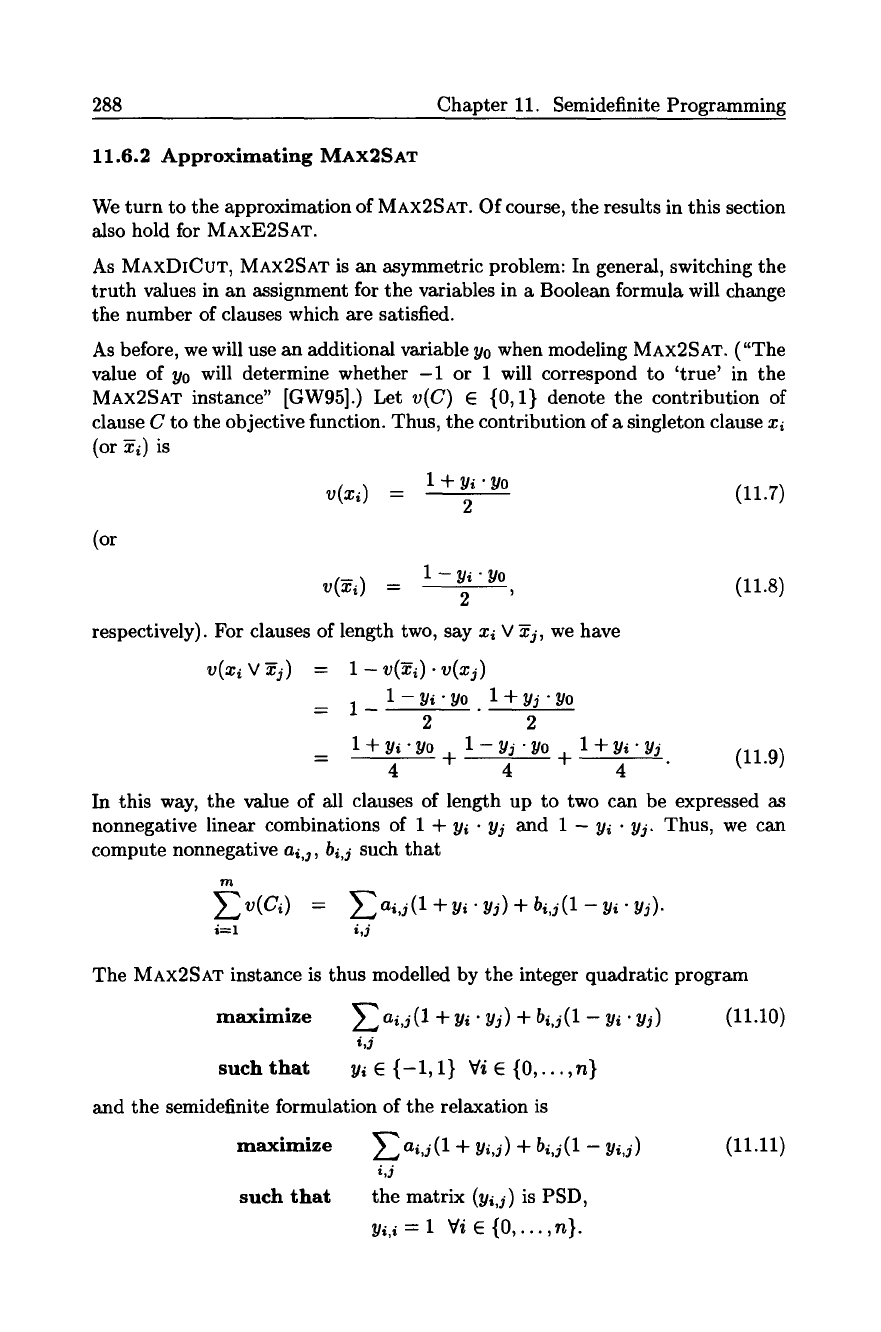
288 Chapter 11. Semidefinite Programming
11.6.2 Approximating MAX2SAT
We turn to the approximation of MAX2SAT. Of course, the results in this section
also hold for MAXE2SAT.
As MAXDICUT, MAX2SAT is an asymmetric problem: In general, switching the
truth values in an assignment for the variables in a Boolean formula will change
the number of clauses which are satisfied.
As before, we will use an additional variable Y0 when modeling MAX2SAT. ("The
value of Yo will determine whether -1 or 1 will correspond to 'true' in the
MAX2SAT instance" [GW95].) Let
v(C) E
{0, 1} denote the contribution of
clause C to the objective function. Thus, the contribution of a singleton clause xi
(or xi) is
v(xi) - 1 +yi.Yo
(11.7)
2
(or
v(~i) - 1 - yi "Yo
(11.8)
2 '
respectively). For clauses of length two, say xi V ~j, we have
1- yi . yo
l+yj.y0
2 2
1 + y~ 9 Yo 1 - yj 9 Y0 + 1 + y~ 9 yj (11.9)
- 4 + 4 4
In this way, the value of all clauses of length up to two can be expressed as
nonnegative linear combinations of 1 + Yi 9 Yj and 1 -
Yi 9 Yj.
Thus, we can
compute nonnegative
ai,~, bi,j
such that
m
Ev(C,)
= Eai,y(1
+yi'yj) + bi,j(1- y,.yy).
i=1
i,j
The MAX2SAT instance is thus modelled by the integer quadratic program
maximize
E ai,j(1 + Yi" Yj) +
bi,j(1 - Yi" Yj) (11.10)
i,j
such that yi e {-1,1}
Vi e {0,...,n}
and the semidefinite formulation of the relaxation is
maximize E ai,j(1 +
Yi,j) + bi,j(1 - Yi,j)
(11.11)
i,j
such that the matrix (Yi,j) is PSD,
Yi,i --- 1 Vie {0,...,n}.

11.7. Combining Approximation Algorithms 289
In the rounding procedure, those variables xi are set to true where the vectors
vi and Vo
of the Cholesky decomposition are on the same side of the random
hyperplane.
By an argument that is similar to the one used in the analysis of MAXCUT, the
expected value of the computed solution is at least 0.878 times the value of an
optimal solution. I.e., we have
Theorem 11.15 ([GW95]). MAX2SAT
(and, thus,
MAXE2SAT)
can be ap-
proximated by a randomized polynomial-time algorithm with approximation ratio
1.139.
1 1.7 Combining Semidefinite Programming with
Classical Approximation Algorithms
Prior to the work in [GW95], at least three different approaches to approximate
MAXEkSAT/MAXSAT have been proposed: Johnson's algorithm, an algorithm
based on network flow, and an algorithm based on linear programming. To dis-
tinguish these approaches from the semidefinite programming technique, we call
them
classical
algorithms.
Johnson's algorithm. Johnson's algorithm [Joh74] is the derandomization
of the probabilistic algorithm where the truth assignment is uniformly cho-
sen among all possible assignments. This algorithm is described in Chapter 2
and derandomized in Chapter 3. MAXEkSAT is solved with approximation ratio
1/(1 - 2-k). The approximation ratio for MAXSAT is at least 2. (Poljak and
Turz~ describe another MAXSAT algorithm that achieves the same approxima-
tion ratio.)
Network flow. Yannakakis [Yan92] describes an approximation algorithm for
MAXSAT which is based on computing maximal flows in networks. Yannakakis'
algorithm is rather involved. Asano et al. [AHOH96] give an outline of this
algorithm. The main idea is to construct several networks. The maximum flow in
these networks is used to partition the set of variables in the Boolean formula into
three classes. The variables in the first (second, third) class are independently
set to be true with probability 0.5 (0.555, 0.75, respectively). The expected value
of the approximation ratio of this algorithm is shown to be 1.334. The algorithm
can be derandomized.
Linear programming. Chapter 2 contains a description of a MAXSAT-algo-
rithm due to Goemans and Williamson [GW94b] which solves the linear re-
laxation of an integer program modeling MAXSAT. The solution of the lin-
ear program determines for each variable the probability with which this vari-
able is set to true. This algorithm solves MAXkSAT with approximation ratio
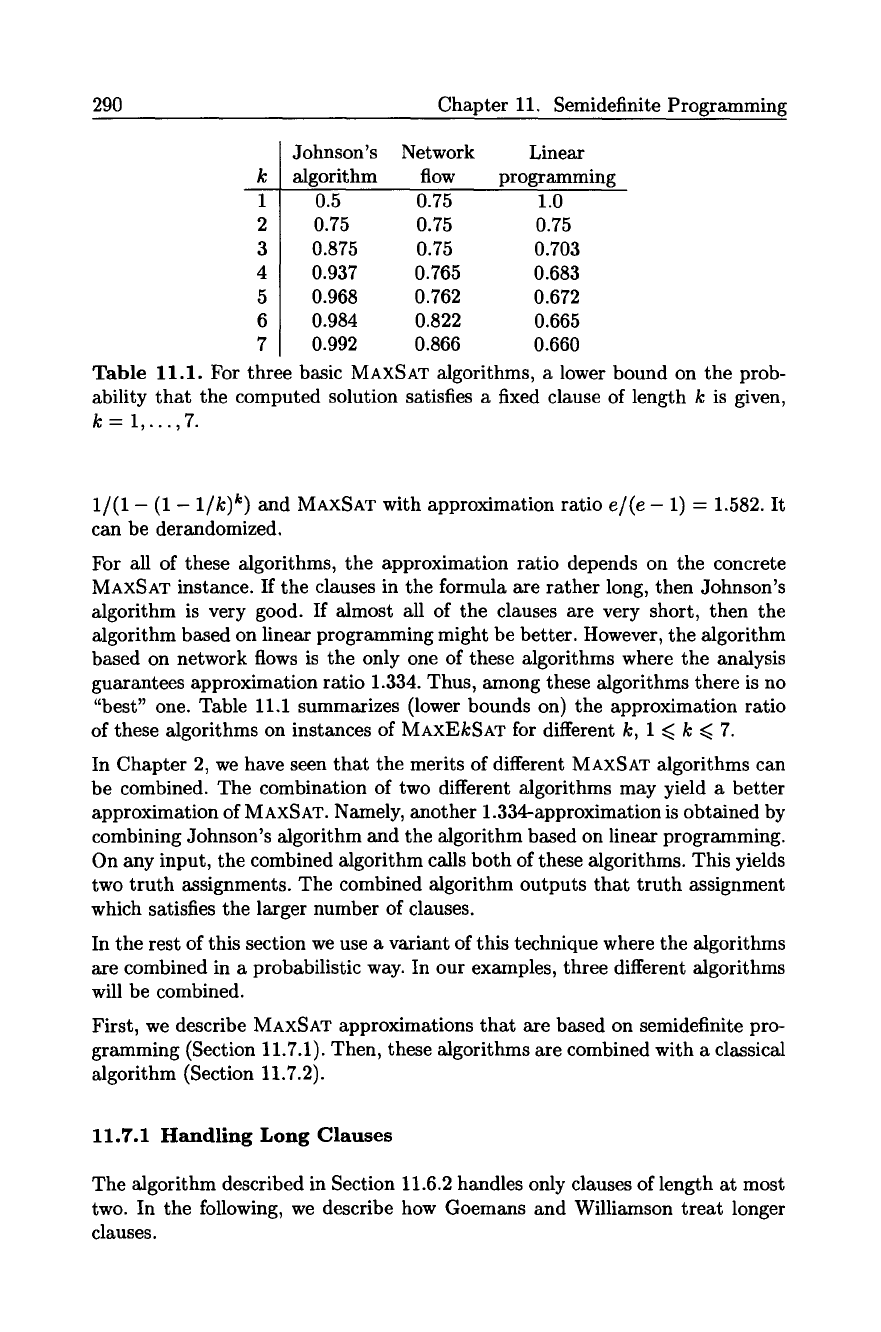
290 Chapter 11. Semidefinite Programming
Johnson's
k algorithm
1 0.5
2 0.75
3 0.875
4 0.937
5 0.968
6 0.984
7 0.992
Network Linear
flow programming
0.75 1.0
0.75 0.75
0.75 0.703
0.765 0.683
0.762 0.672
0.822 0.665
0.866 0.660
Table 11.1.
For three basic MAXSAT algorithms, a lower bound on the prob-
ability that the computed solution satisfies a fixed clause of length k is given,
k= 1,...,7.
1/(1 - (1 - l/k) k) and MAXSAT with approximation ratio e/(e - 1) ---- 1.582. It
can be derandomized.
For all of these algorithms, the approximation ratio depends on the concrete
MAXSAT instance. If the clauses in the formula are rather long, then Johnson's
algorithm is very good. If almost all of the clauses are very short, then the
algorithm based on linear programming might be better. However, the algorithm
based on network flows is the only one of these algorithms where the analysis
guarantees approximation ratio 1.334. Thus, among these algorithms there is no
"best" one. Table 11.1 summarizes (lower bounds on) the approximation ratio
of these algorithms on instances of MAxEkSAT for different k, 1 ~< k ~< 7.
In Chapter 2, we have seen that the merits of different MAXSAT algorithms can
be combined. The combination of two different algorithms may yield a better
approximation of MAXSAT. Namely, another 1.334-approximation is obtained by
combining Johnson's algorithm and the algorithm based on linear programming.
On any input, the combined algorithm calls both of these algorithms. This yields
two truth assignments. The combined algorithm outputs that truth assignment
which satisfies the larger number of clauses.
In the rest of this section we use a variant of this technique where the algorithms
are combined in a probabilistic way. In our examples, three different algorithms
will be combined.
First, we describe MAXSAT approximations that are based on semidefinite pro-
gramming (Section 11.7.1). Then, these algorithms are combined with a classical
algorithm (Section 11.7.2).
11.7.1 Handling Long Clauses
The algorithm described in Section 11.6.2 handles only clauses of length at most
two. In the following, we describe how Goemans and Williamson treat longer
clauses.

11.7. Combining Approximation Algorithms 291
Let r = C1 A ... A
Cm
be a Boolean formula in conjunctive normal form. For
any clause
Cj
let t(Cj) denote the length of the clause and let I + (or Ij--) denote
the set of non-negated (negated, respectively) variables in
Cj.
Recall Goemans and Williamson's formulation of ~b as a
linear program
((2.1) in
Chapter 2):
maximize
Ejm=l zj
(11.12)
such that
~iei+ Yi
+ ~ieI;-
(1 -
Yi) >~ z3 Vj 9
{1,...,m}
0 .< y, .< 1 vi9 {1,...,n}
0 <~ zj
~< 1 Vje{1,...,m}
In a very
MAXSAT is modelled by
m
maximize
~j=l zj
such that
~ie~+ v(xi) + ~iez 7 v(~i) >/ zj
v(C~) >1 zj
Yi'Yi = 1
0~<zj.<l
similar way, by using the function v introduced in (11.7)-(11.9),
(11.13)
Vj 9 {1,...,m}
Vj 9 {1,..., m}, t(C#) = 2
Vi 9 {0,...,n}
vj
9
{1,...,m}.
To obtain the corresponding semidefinite formulation, replace each vector prod-
uct
Yi 9 Yk
by a new variable
Yi,k.
As restrictions, we get that the matrix A1 :=
(Yi,k)i,kE{O
..... n} is PSD and that a system of linear inequalities in the vari-
ables
Yi,k, i,k e
{0,...,n}, and zj, j E {1,...,m} is satisfied. As noted in
Section 11.3, the linear inequalities can be transformed into a matrix A2 :=
SP(yo,o,..., yn,~, zl,..., zm)
which is PSD if and only if all inequalities are sat-
isfied. Let A be the matrix
0 A2]
which is PSD if and only if Ax and
A2 are
PSD. Then
m
maximize ~ zj (11.14)
j=l
such that matrix A is PSD
Yi,i = l
ViE{0,...,n}
is the corresponding semidefinite relaxation.
Let Yi,k and ~j denote the value of the variables in a solution of (11.14).
By A1, we denote the algorithm which computes the Cholesky decomposition
of the matrix
(fti,k)
and applies Goemans-Williamson's rounding procedure to
the solution (as described in Section 11.6.2). For each clause Cj of length one or
tWO,
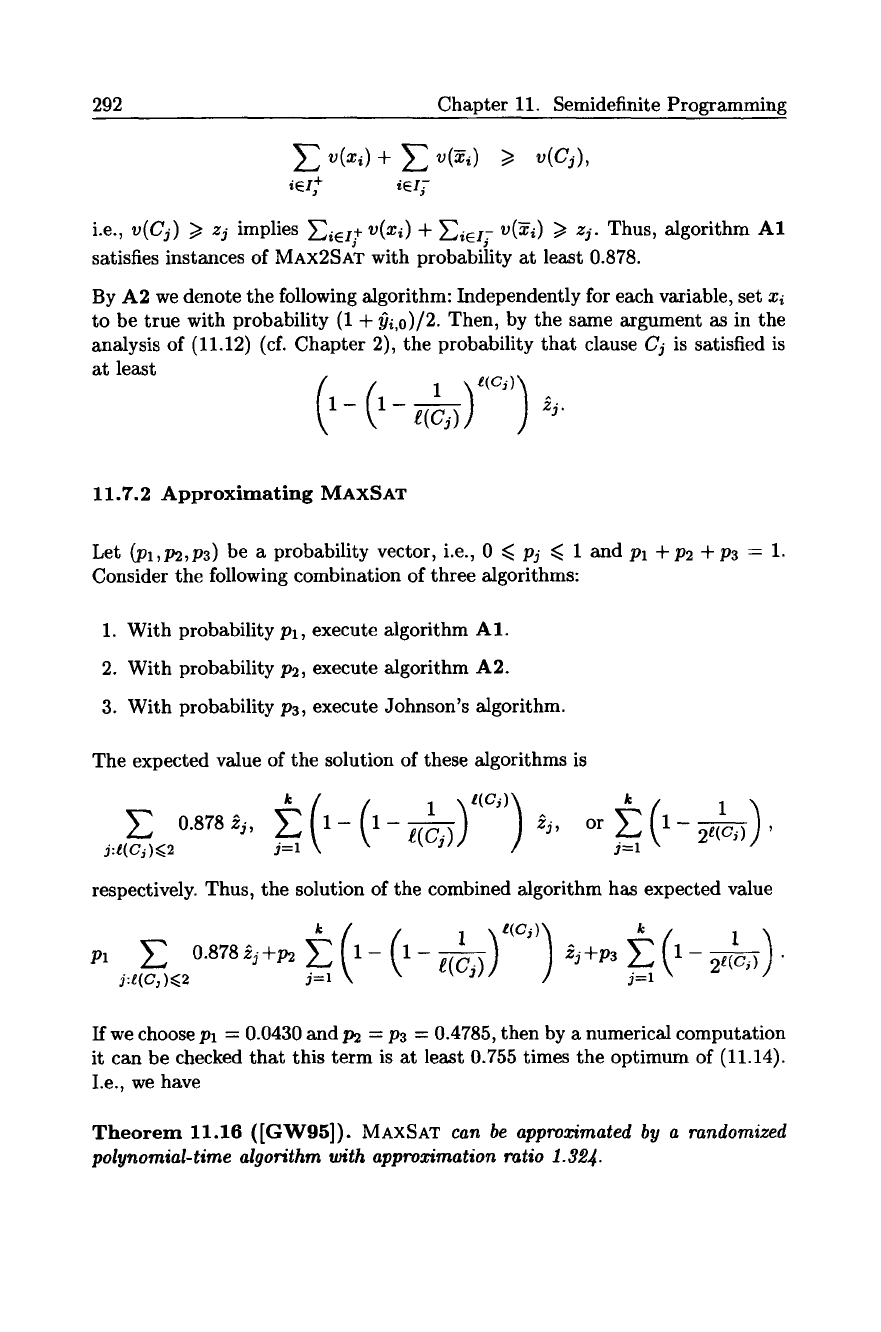
292 Chapter 11. Semidefinite Programming
v(x,) + >/ ,(cj),
ie , + iel;
i.e.,
v(Cj) >~ zj
implies ~-~iei+
v(xi) + ~-,iel; v(~i) >1 zj.
Thus, algorithm A1
satisfies instances of MAX2SAT with probability at least 0.878.
By A2 we denote the following algorithm: Independently for each variable, set
xi
to be true with probability (1 + ~i,0)/2. Then, by the same argument as in the
analysis of (11.12) (cf. Chapter 2), the probability that clause Cj is satisfied is
at least
11.7.2 Approximating MAXSAT
Let (Pl,P2,p3) be a probability vector, i.e., 0 ~ pj ~ 1 and Pl +P2 +Pa = 1.
Consider the following combination of three algorithms:
1. With probability Pa, execute algorithm A1.
2. With probability P2, execute algorithm A2.
3. With probability P3, execute Johnson's algorithm.
The expected value of the solution of these algorithms is
Z 0.878s 1-1 g(~j) s or 1
j:t(Cj)~<2 j=l j----1 2t('C5) '
respectively. Thus, the solution of the combined algorithm has expected value
j:~(C~)
~<2 j=l
j=l
If we choose Pl : 0.0430 and P2 : P3 = 0.4785, then by a numerical computation
it can be checked that this term is at least 0.755 times the optimum of (11.14).
I.e., we have
Theorem 11.16 ([GW95]). MAXSAT
can be approximated by a randomized
polynomial-time algorithm with approximation ratio 1.324.
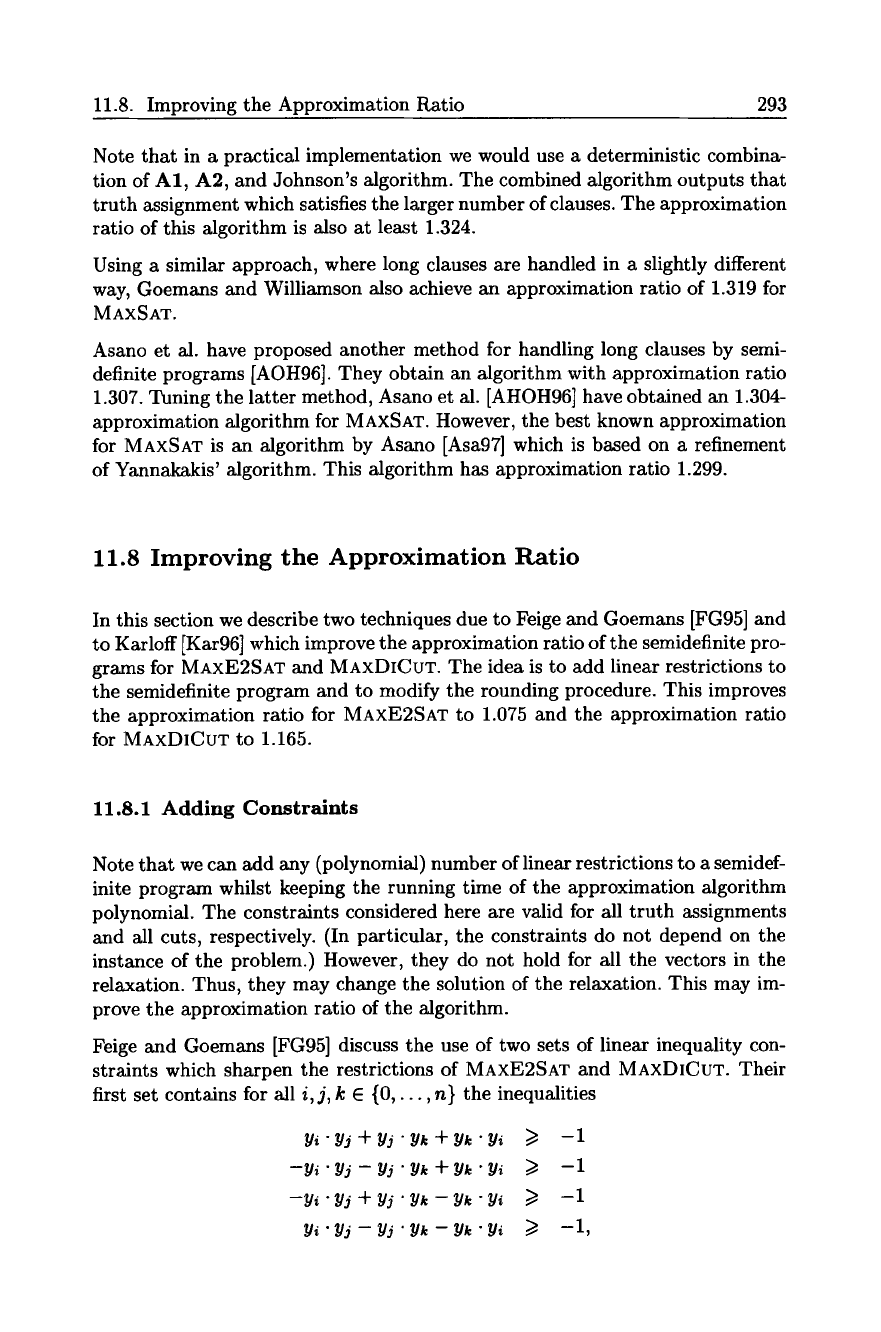
11.8. Improving the Approximation Ratio 293
Note that in a practical implementation we would use a deterministic combina-
tion of A1, A2, and Johnson's algorithm. The combined algorithm outputs that
truth assignment which satisfies the larger number of clauses. The approximation
ratio of this algorithm is also at least 1.324.
Using a similar approach, where long clauses are handled in a slightly different
way, Goemans and Williamson also achieve an approximation ratio of 1.319 for
MAXSAT.
Asano et al. have proposed another method for handling long clauses by semi-
definite programs [AOH96]. They obtain an algorithm with approximation ratio
1.307. Tuning the latter method, Asano et al. [AHOH96] have obtained an 1.304-
approximation algorithm for MAXSAT. However, the best known approximation
for MAXSAT is an algorithm by Asano [Asa97] which is based on a refinement
of Yannakakis' algorithm. This algorithm has approximation ratio 1.299.
11.8 Improving the Approximation Ratio
In this section we describe two techniques due to Feige and Goemans [FG95] and
to Karloff [Kar96] which improve the approximation ratio of the semidefinite pro-
grams for MAXE2SAT and MAXDICUT. The idea is to add linear restrictions to
the semidefinite program and to modify the rounding procedure. This improves
the approximation ratio for MAXE2SAT to 1.075 and the approximation ratio
for MAXDICUT to 1.165.
11.8.1 Adding Constraints
Note that we can add any (polynomial) number of linear restrictions to a semidef-
inite program whilst keeping the running time of the approximation algorithm
polynomial. The constraints considered here are valid for all truth assignments
and all cuts, respectively. (In particular, the constraints do not depend on the
instance of the problem.) However, they do not hold for all the vectors in the
relaxation. Thus, they may change the solution of the relaxation. This may im-
prove the approximation ratio of the algorithm.
Feige and Goemans [FG95] discuss the use of two sets of linear inequality con-
stralnts which sharpen the restrictions of MAxE2SAT and MAXDICUT. Their
first set contains for all
i,j, k E
{0,..., n} the inequalities
Yi'Yj+Yj'Yk+Yk'Yi >1 --1
--Yi'Yj--Yj'Yk+Yk'Yi >/ --1
--Yi "yj"kyj'yk--yk "Yi ~ --1
Yi'Yj--Yj'Yk--Yk'Yi ~ --1,
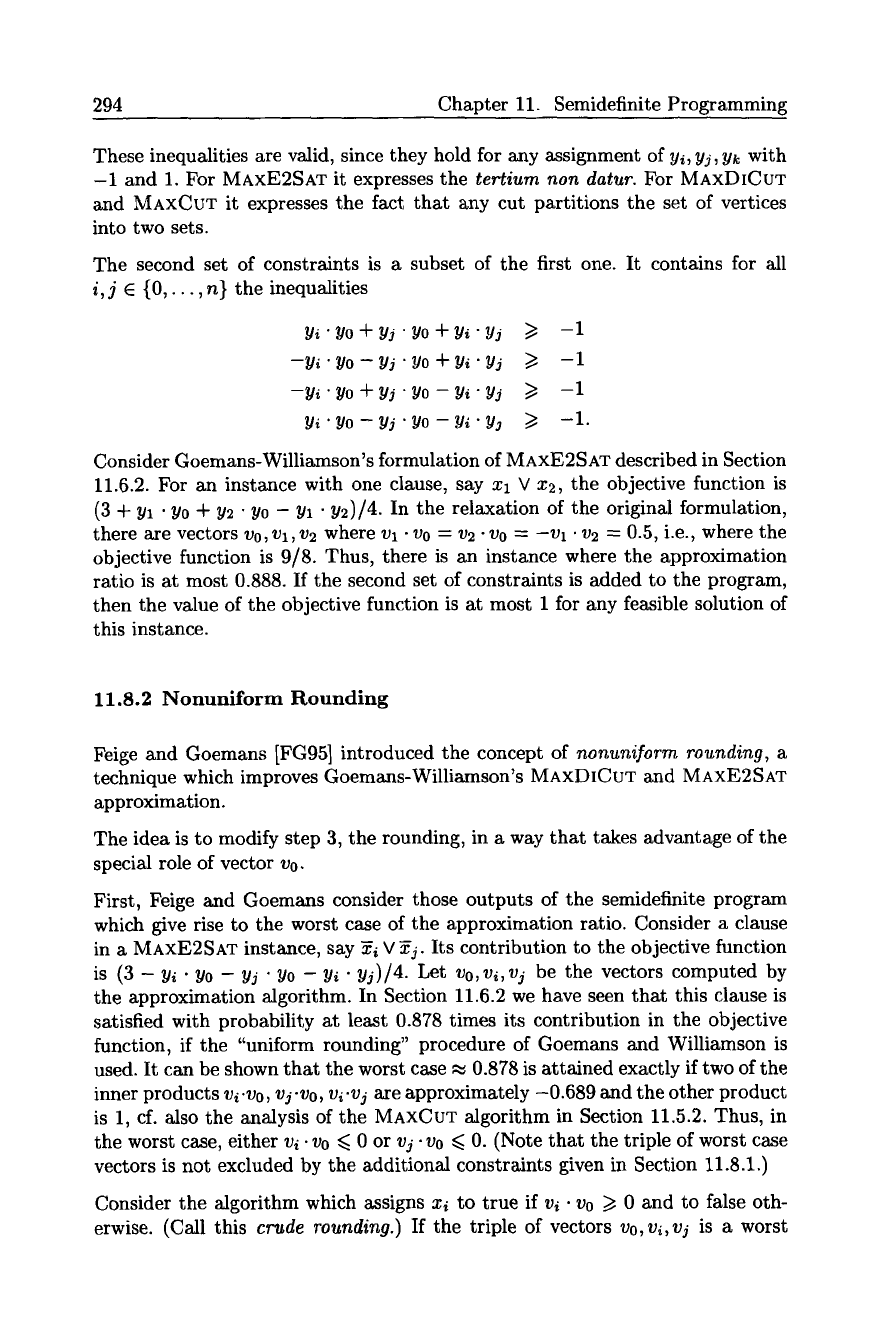
294 Chapter 11. Semidefinite Programming
These inequalities are valid, since they hold for any assignment of
Yi, Yj, Yk
with
-1 and 1. For MAxE2SAT it expresses the
tertium non datur.
For MAxDICuT
and MAXCUT it expresses the fact that any cut partitions the set of vertices
into two sets.
The second set of constraints is a subset of the first one. It contains for all
i,j E
{0,... ,n} the inequalities
yi'Yo+yj'Yo+Yi'Yj >/ -1
-yi'y0-yj'Y0+Yi'Yj >t -1
-yi'yo+yj'Y0-Y~'Yj /> -1
yi'yo-yj'Yo-Yi'Y3 /> -1.
Consider Goemans-Williamson's formulation of MAXE2SAT described in Section
11.6.2. For an instance with one clause, say xl V x2, the objective function is
(3 + Yl 9 Y0 + y2 9 yo - Yl 9 y2)/4. In the relaxation of the original formulation,
there are vectors v0, vl, v2 where vl -v0 -- v2 -v0 = -vl .v2 = 0.5, i.e., where the
objective function is 9/8. Thus, there is an instance where the approximation
ratio is at most 0.888. If the second set of constraints is added to the program,
then the value of the objective function is at most 1 for any feasible solution of
this instance.
11.8.2 Nonuniform Rounding
Feige and Goemans [FG95] introduced the concept of
nonuniform rounding, a
technique which improves Goemans-Williamson's MAxDICUT and MAXE2SAT
approximation.
The idea is to modify step 3, the rounding, in a way that takes advantage of the
special role of vector v0.
First, Feige and Goemans consider those outputs of the semidefinite program
which give rise to the worst case of the approximation ratio. Consider a clause
in a MAXE2SAT instance, say xi V ~j. Its contribution to the objective function
is (3
- Yi 9 Yo - Yj " Yo - Yi 9 yj)/4.
Let
Vo,Vi,Vj
be the vectors computed by
the approximation algorithm. In Section 11.6.2 we have seen that this clause is
satisfied with probability at least 0.878 times its contribution in the objective
function, if the "uniform rounding" procedure of Goemans and Williamson is
used. It can be shown that the worst case ~ 0.878 is attained exactly if two of the
inner products
vcvo, vj.vo, vcvj are
approximately -0.689 and the other product
is 1, cf. also the analysis of the MAXCUT algorithm in Section 11.5.2. Thus, in
the worst case, either vi- v0 ~< 0 or
vj. vo <~ O.
(Note that the triple of worst case
vectors is not excluded by the additional constraints given in Section 11.8.1.)
Consider the algorithm which assigns xi to true if vi 9 v0 ~> 0 and to false oth-
erwise. (Call this
crude rounding.)
If the triple of vectors
vo,vi,vj
is a worst
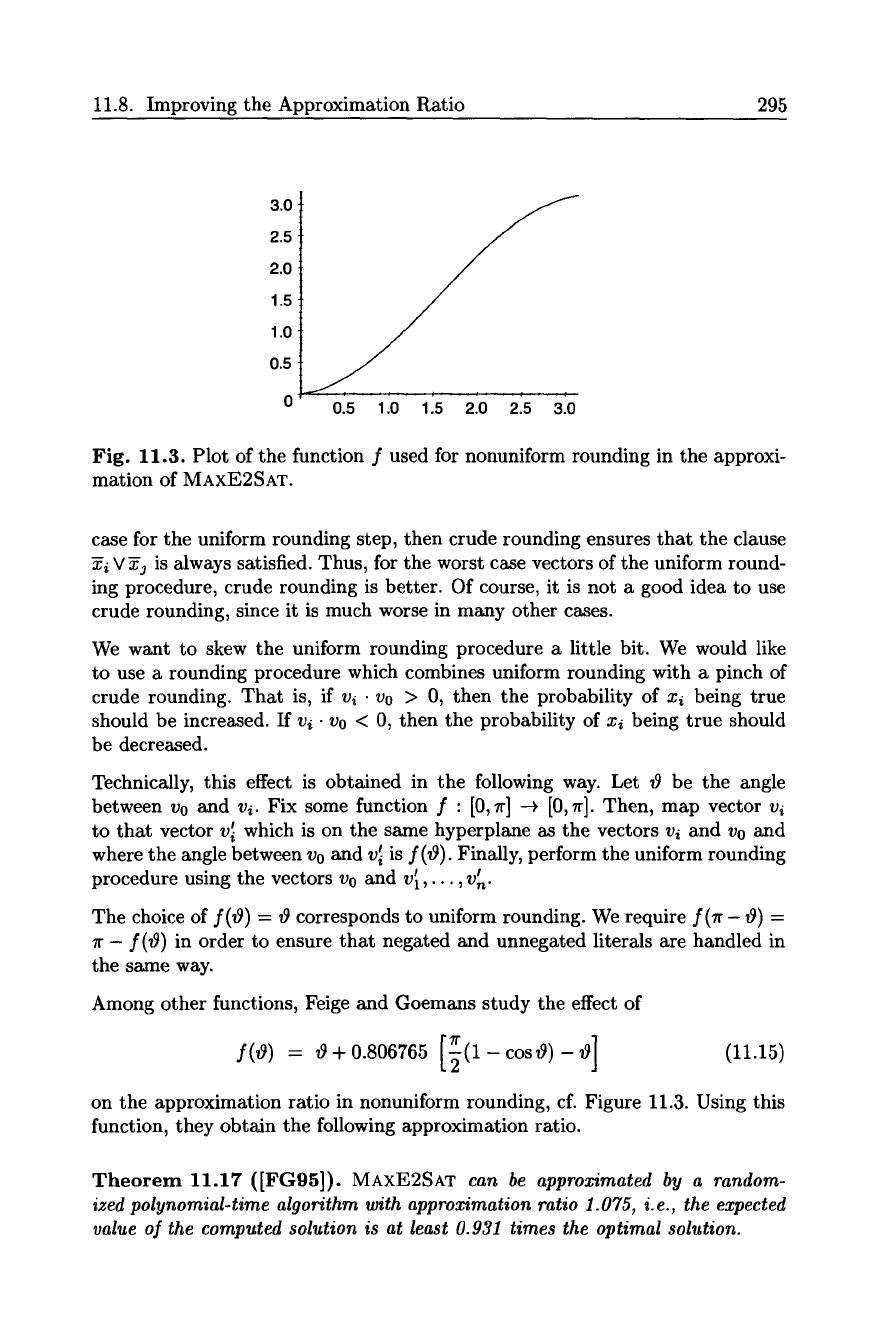
11.8. Improving the Approximation Ratio 295
3.0"
2.5
2.0
1.5
1.0
0.5
0
0.5 1.0 1.5 2.0 2.5 3.0
Fig. 11.3. Plot of the function f used for nonuniform rounding in the approxi-
mation of MAXE2SAT.
case for the uniform rounding step, then crude rounding ensures that the clause
5i V~ is always satisfied. Thus, for the worst case vectors of the uniform round-
ing procedure, crude rounding is better. Of course, it is not a good idea to use
crude rounding, since it is much worse in many other cases.
We want to skew the uniform rounding procedure a little bit. We would like
to use a rounding procedure which combines uniform rounding with a pinch of
crude rounding. That is, if vi 9 Vo > 0, then the probability of xi being true
should be increased. If vi 9 v0 < 0, then the probability of xi being true should
be decreased.
Technically, this effect is obtained in the following way. Let ~ be the angle
between v0 and vi. Fix some function f : [0, ~r] -~ [0, 7[]. Then, map vector vi
to that vector v~ which is on the same hyperplane as the vectors v~ and v0 and
where the angle between Vo and v~ is f(tg). Finally, perform the uniform rounding
!
procedure using the vectors v0 and v~,...,
v n.
The choice of f(tg) = 0 corresponds to uniform rounding. We require ](~r - tg) =
7r - f(tg) in order to ensure that negated and unnegated literals are handled in
the same way.
Among other functions, Feige and Goemans study the effect of
: , +o.8o6765
(11.15)
on the approximation ratio in nonuniform rounding, cf. Figure 11.3. Using this
function, they obtain the following approximation ratio.
Theorem 11.17 ([FG95]). MAXE2SAT
can be approximated by a random-
ized polynomial-time algorithm with approximation ratio 1.075, i.e., the expected
value of the computed solution is at least 0.931 times the optimal solution.
